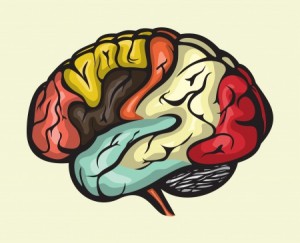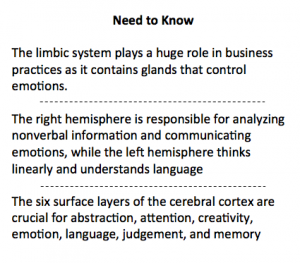Your Brain: By the Numbers
June 20, 2015 ~ Written by: W.B. “Bud” Kirchner
“If the brain were so simple we could understand it, we would be so simple we couldn’t.” – Lyall Watson
It is with some embarrassment I finally get around to articles focused on the brain. My embarrassment is exacerbated by the irony that I have done a few articles involving the ‘second brain’ but nothing on the first brain.
So – my objective here is to layout the “playing field” of the Business Brain Model.
As always I will try to go light on the details and focus on relevant stuff and in this case I have organized the salient aspects “by the numbers.”
One emotional center
Ignoring for the moment my previous writing on the body/brain (including the second brain) and the ubiquitous interactions across areas of the brain, which you will see noted under various lobes, today I am focused on the limbic system which is your emotional control center.
The limbic system contains glands that help manifest your emotions. Many hormonal responses that your body generates are initiated in this area. The limbic system includes the amygdala, hippocampus, hypothalamus and thalamus.
I am singling out the limbic system because of the role emotions play in everything we do in business – decisions, communications etc. This system is also relevant to memories – given most carry an emotional ‘tag.’
Two hemispheres
“You have two hemispheres in your brain – a left and a right side. The left side controls the right side of your body and right controls the left half. It’s a fact. Therefore, left-handers are the only people in their right minds.” ~ W.C. Fields (also attributed later to Bill “Spaceman” Lee)
- Right Hemisphere (the creativity hemisphere)
- Focuses on right here/right now
- Controls the left side of the body
- Attends to temporal and spatial relationships
- Analyzes nonverbal information
- Communicates emotion
- Left Hemisphere (the logic hemisphere)
- Controls the right side of the body
- Produces and understands language
- Thinks linearly and methodically
(If you want an inspirational description on the two hemispheres – watch Jill Bolte Taylor’s TED Talk (https://www.ted.com/talks/jill_bolte_taylor_s_powerful_stroke_of_insight).
The cerebellum is much like the cerebrum in that it also has two hemispheres (and many of the folds we will discuss).
Three main parts
The brain is made of the forebrain, midbrain and hindbrain. The forebrain contains the cerebrum, thalamus and hypothalamus (part of the limbic system). The midbrain, housing the tectum and tegmentum (and connecting the brainstem to the thalamus), is involved in input from senses. The hindbrain consists of the cerebellum, pons and medulla. The midbrain, pons and medulla, all together, are usually called the brainstem or hindbrain.
Focusing on the parts you are most likely to hear about:
- The cerebrum is the largest part of the brain. It consists of four lobes and their related functions (see next section below).
The limbic system is located deep within the cerebrum. (See more in our decision-making or communication sections. )
- The cerebellum sits at the back of your head, under the cerebrum. It controls coordination and balance. Literally, the name means ‘little brain’ in Latin.
(See more in our body and brain sections)
- The brain stem is located in front of your cerebellum and sits beneath your cerebrum. It controls automatic functions like breathing, digestion, heart rate and blood pressure and it connects the brain to the spinal cord.
(See more in our second brain sections)
Four lobes
The cerebrum is composed of four lobes – each with primary functions but with considerable overlap:
- Frontal Lobe
- Creative thoughts
- Behavior/inhibition
- Abstract thought processes
- Problem solving
- Personality
- Some emotion
- Intellect
- Word meaning
- Occipital Lobe
- Sight
- Reading
- Parietal Lobe
- Tactile sensation
- Response to internal stimuli (proprioception)
- Taste
- Body awareness
- Temporal Lobe
- Hearing
- Long term memory
- Music
- Some speech
- Sense of identity
- Some emotion
Five senses
As you will note huge amounts of various parts of the brain are devoted to processing your sensory input. We gather information and relate to the world around us via the sensory input to the brain. Sensory input is related to cognitive base, memory creation – the list goes on.
Six layers
Higher functions occur in the highly wrinkled (to increase the area) six surface layers of the cerebral cortex which represents the bulk of your cerebrum.
These areas are crucial in your complex cortical functions that include abstraction, attention, creativity, emotion, language, judgment, and memory. They are also involved in the combination/composition of your movements.
“The brain is wider than the sky.” ~ Emily Dickinson
Seven is the Thinker, the Seeker
I don’t buy into Numerology, but I had to throw that out there since it lined up with our numeric count and it timed perfect for me to toss this conversation over to you.
For the do it yourselfers, I am reminded about one of the classics from my library:
- “How to Build a Brain: A Neural Architecture for Biological Cognition” – Chris Eliasmith
Full disclosure: although I’ve had this book since it was published (2013) I’ve yet to make it to the end. Prepare for heavy slugging!
And finally, if you are visual oriented watch Allan Jones’ TED Talk “A Map of the Brain.” He will literally give you a guided tour of a real brain and then drive you through a topographical-like map of the brain. Enjoy!
About the Author: W.B. “Bud” Kirchner is a serial entrepreneur and philanthropist with more than 50 years of business success. He is not a scientist or an academic but he does have a diversified exposure to neuroscience, psychology and related cognitive sciences. Generally speaking, the ideas he expresses here are business-angled expansions of other people’s ideas, so when possible, he will link to the original reference.

